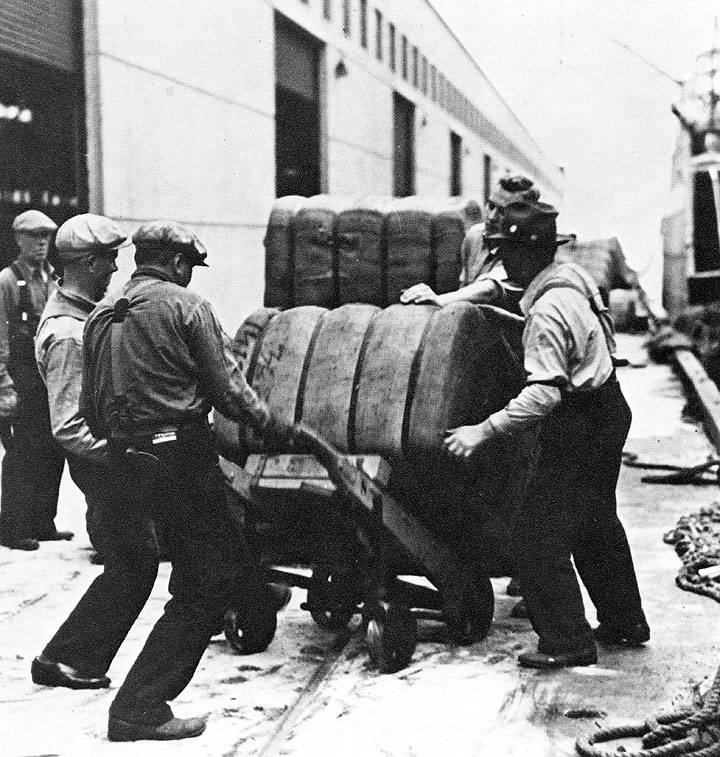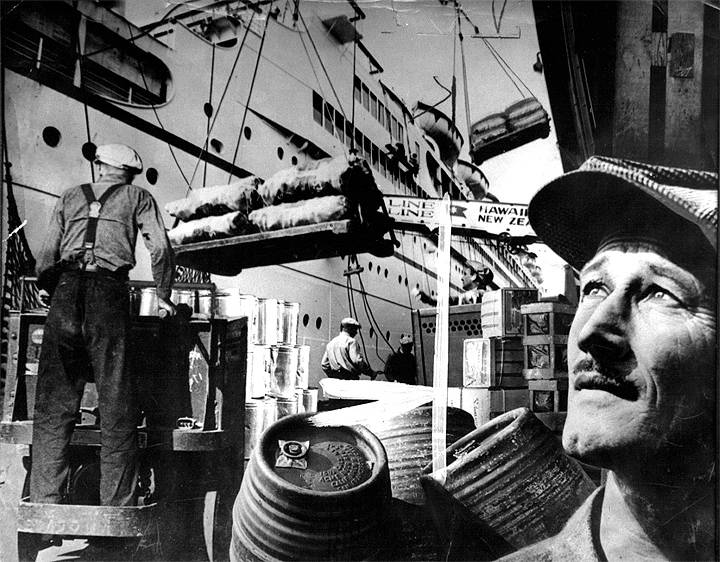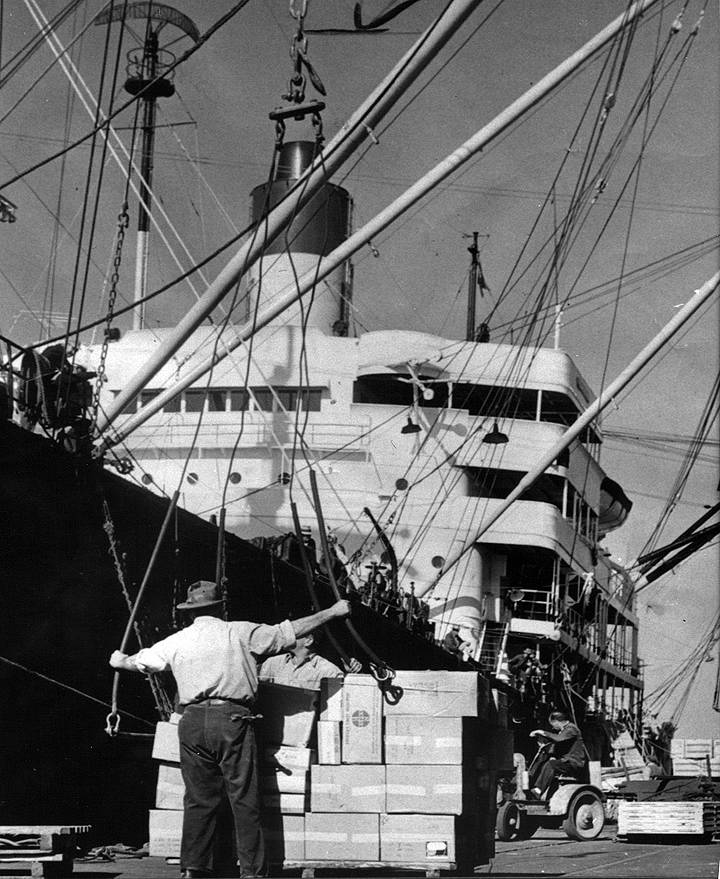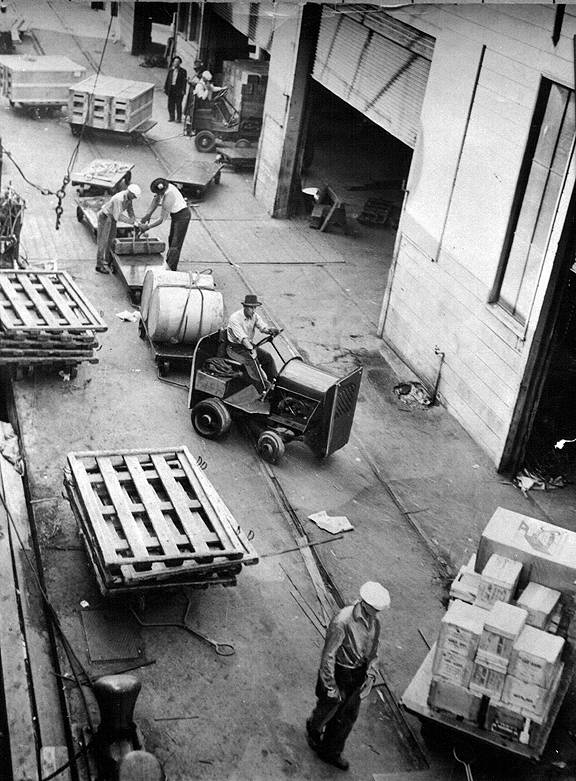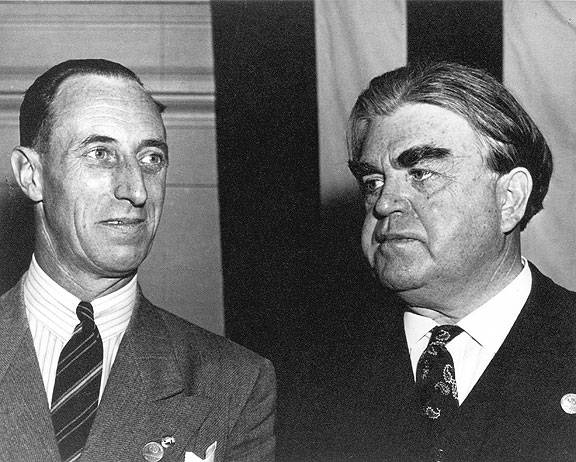Harry Bridges cont'd.: Difference between revisions
(PC and fixed quotes) |
No edit summary |
||
| (4 intermediate revisions by the same user not shown) | |||
| Line 3: | Line 3: | ||
''by Harvey Schwartz, a San Francisco-born labor historian'' | ''by Harvey Schwartz, a San Francisco-born labor historian'' | ||
[[Image: | [[Image:33LNGSHR.jpg]] | ||
'''Longshoremen working on a pier.''' | '''Longshoremen working on a pier, c. 1933.''' | ||
''Photo: ILWU Archives'' | ''Photo: ILWU Archives'' | ||
[[Image:Longshore-early-montage.jpg]] | |||
'''Montage of longshore work, c. 1950s.''' | |||
''Photo: San Francisco History Center, SF Public Library'' | |||
After the Second World War, however, scholarly opinions began to shift against Bridges. The consensus generation of writers, influenced by the Cold War preoccupations of the larger society, were by and large hostile to those who openly admired the Soviet Union or who were identified with the left. Inside the labor movement itself the beginning of the American postwar anti-Communist crusade was heralded by late 1946. At the CIO's national convention President Philip Murray -- who had defended Bridges' patriotic contributions to the war effort and had pledged that "the CIO will continue its aggressive campaign in the defense of Mr. Bridges," introduced a resolution disavowing communist union control. Bridges' wartime support of labor's no-strike pledge, which the Communist Party had also favored, became an issue, as did his support of the 1948 Henry Wallace campaign, which the CIO officially opposed. During that same election year Murray fired Bridges as CIO Regional Director for Northern California, and in 1950 the CIO purged its leading left-wing unions, including Bridges' ILWU, to demonstrate its opposition to Communism. | After the Second World War, however, scholarly opinions began to shift against Bridges. The consensus generation of writers, influenced by the Cold War preoccupations of the larger society, were by and large hostile to those who openly admired the Soviet Union or who were identified with the left. Inside the labor movement itself the beginning of the American postwar anti-Communist crusade was heralded by late 1946. At the CIO's national convention President Philip Murray -- who had defended Bridges' patriotic contributions to the war effort and had pledged that "the CIO will continue its aggressive campaign in the defense of Mr. Bridges," introduced a resolution disavowing communist union control. Bridges' wartime support of labor's no-strike pledge, which the Communist Party had also favored, became an issue, as did his support of the 1948 Henry Wallace campaign, which the CIO officially opposed. During that same election year Murray fired Bridges as CIO Regional Director for Northern California, and in 1950 the CIO purged its leading left-wing unions, including Bridges' ILWU, to demonstrate its opposition to Communism. | ||
| Line 15: | Line 21: | ||
The identification of Bridges with Stalinism was assumed by most labor scholars in the 1950s and early 1960s. Like the popular writer Sam Stavidsky, whose "Communist Penetration of the CIO" appeared in 1950, academics like Max M. Kampelman came to rely heavily upon coincidence and insinuation to establish the longshore leader's association with the Communist Party. Many scholars focused exclusively upon the issue of Bridges' political affiliation. Jane Cassels' Record, for example, devoted several pages of her 1954 dissertation to establishing that "the parallelism of Bridges' policies with those of the Communist Party over time is persuasive" and went on to argue that Bridges' whole world view was Stalinist. Among those who came to assume that Bridges followed the party line were some of the leading scholars of the day, including Daniel Bell, Wytze Gorter, George H. Hildebrand, Irving Howe, Lewis Coser, Bernard Karsh, Philips L. Garman, David A. Shannon, David J. Saposs, Walter Galenson, and Nathan Glazer. A few authors like Joseph P. Goldberg, who merely wrote that Bridges was "influenced by the tactics and philosophy of the Communist Party," were cautious in their approach. But others, like Arthur M. Schlesinger, Jr., who characterized Bridges as a man "with scruples" who "rarely deviated from the Communist line," were not. | The identification of Bridges with Stalinism was assumed by most labor scholars in the 1950s and early 1960s. Like the popular writer Sam Stavidsky, whose "Communist Penetration of the CIO" appeared in 1950, academics like Max M. Kampelman came to rely heavily upon coincidence and insinuation to establish the longshore leader's association with the Communist Party. Many scholars focused exclusively upon the issue of Bridges' political affiliation. Jane Cassels' Record, for example, devoted several pages of her 1954 dissertation to establishing that "the parallelism of Bridges' policies with those of the Communist Party over time is persuasive" and went on to argue that Bridges' whole world view was Stalinist. Among those who came to assume that Bridges followed the party line were some of the leading scholars of the day, including Daniel Bell, Wytze Gorter, George H. Hildebrand, Irving Howe, Lewis Coser, Bernard Karsh, Philips L. Garman, David A. Shannon, David J. Saposs, Walter Galenson, and Nathan Glazer. A few authors like Joseph P. Goldberg, who merely wrote that Bridges was "influenced by the tactics and philosophy of the Communist Party," were cautious in their approach. But others, like Arthur M. Schlesinger, Jr., who characterized Bridges as a man "with scruples" who "rarely deviated from the Communist line," were not. | ||
In the mid-1960s, with the bitterness of the McCarthy period abating, scholars began to modify their view of Bridges. Philip Taft, for example, wrote in 1964 that although "Bridges followed the line of the Communist Party," the longshore leader had "never neglected his trade union work; his members have the best conditions of any longshoremen in the world." Taft also depicted Bridges as "one of the most able unionists of the last three decades." Two books by the well-known writer Paul Jacobs clearly reflected the extent of changing attitudes towards Bridges. In 1963 Jacobs, an ex-Trotskyist, described his role in helping to prepare the CIO's brief | [[Image:Longshore-dock-pallet-crane.jpg]] | ||
'''Longshore work in San Francisco, c. 1950s.''' | |||
''Photo: San Francisco History Center, SF Public Library'' | |||
In the mid-1960s, with the bitterness of the McCarthy period abating, scholars began to modify their view of Bridges. Philip Taft, for example, wrote in 1964 that although "Bridges followed the line of the Communist Party," the longshore leader had "never neglected his trade union work; his members have the best conditions of any longshoremen in the world." Taft also depicted Bridges as "one of the most able unionists of the last three decades." Two books by the well-known writer Paul Jacobs clearly reflected the extent of changing attitudes towards Bridges. In 1963 Jacobs, an ex-Trotskyist, described his role in helping to prepare the CIO's brief recommending the 1950 expulsion of the longshore union. "I must admit," Jacobs wrote, "much as I hate to provide Bridges with ammunition to prove the assertions he made at the time, that there was very little due process in the trial." Two years later Jacobs revealed that long after the CIO purge he had become "obsessed with Harry Bridges, as if a constant war were going on inside me, one side still reacting to the way I thought he'd followed the twists and turns in the Communist line, and the other side filled with guilt for the way in which I had helped push him out of the CIO." Fifteen years after America's anti-Communist crusade, even one of Bridges' old enemies was ready to concede that the longshore leader had been treated unfairly in the 1950s. | |||
Perhaps a similar sense of guilt for the unfair treatment Bridges had received at the hands of the government and of historians accounts for the moderation in recent scholarly assessments. In ''Turbulent Years'', a major history of the 1930s published in 1970, Irving Bernstein presented a carefully balanced account of Bridges' early career, even if he concluded that the unionist "worked with Communists, he hired them, he sought the help of the Communist Party and its instrumentalities, and he often, though by no means always, adopted their ideas and followed their line." | Perhaps a similar sense of guilt for the unfair treatment Bridges had received at the hands of the government and of historians accounts for the moderation in recent scholarly assessments. In ''Turbulent Years'', a major history of the 1930s published in 1970, Irving Bernstein presented a carefully balanced account of Bridges' early career, even if he concluded that the unionist "worked with Communists, he hired them, he sought the help of the Communist Party and its instrumentalities, and he often, though by no means always, adopted their ideas and followed their line." | ||
Charles P. Larrowe, in his 1972 biography of Bridges, described at length the many government efforts to deport the longshore leader. In so doing, he was very careful, as he had been in his earlier works in the field, to avoid emotionally charged anti-Communist statements. In his provocative book on the American Communist Party's problems during 1943-1957, also published in 1972, Joseph R. Starobin, an ex-Communist turned political science professor, acknowledged Bridges' independence. Bridges, Starobin wrote, "was never a Communist." If the longshore leader "enjoyed imitate ties with the Party" it was "usually on his own terms." | [[Image:Dock-work.jpg|576px|left|thumb|'''Longshoremen work the docks, c. 1950s'''; ''Photo: San Francisco History Center, SF Public Library'']] Charles P. Larrowe, in his 1972 biography of Bridges, described at length the many government efforts to deport the longshore leader. In so doing, he was very careful, as he had been in his earlier works in the field, to avoid emotionally charged anti-Communist statements. In his provocative book on the American Communist Party's problems during 1943-1957, also published in 1972, Joseph R. Starobin, an ex-Communist turned political science professor, acknowledged Bridges' independence. Bridges, Starobin wrote, "was never a Communist." If the longshore leader "enjoyed imitate ties with the Party" it was "usually on his own terms." | ||
Reviewing the CIO purge of the ILWU in a recent dissertation, James R. Prickett convincingly emphasized the "serious shortcomings of the CIO's case." Interestingly, though, Bert Cochran, a union activist who became an academic, seemed to echo earlier scholars in his 1977 study of labor and communism. He stressed that "sociologically" Bridges "was an ally of the Communists, conferred with Communist leaders, adhered to Communist policy, and helped build up the Communist faction inside his union." | Reviewing the CIO purge of the ILWU in a recent dissertation, James R. Prickett convincingly emphasized the "serious shortcomings of the CIO's case." Interestingly, though, Bert Cochran, a union activist who became an academic, seemed to echo earlier scholars in his 1977 study of labor and communism. He stressed that "sociologically" Bridges "was an ally of the Communists, conferred with Communist leaders, adhered to Communist policy, and helped build up the Communist faction inside his union." | ||
| Line 38: | Line 50: | ||
Later Bridges continued to search for the widest possible basis of cooperation among transportation unions, but never with the success he sought. His support of a Committee for Maritime Unity shortly after World War II was challenged as a Communist ploy. In recent years, when he investigated the possibilities of uniting his union either with the east coast International Longshoremen's Association or with the Teamsters, he was criticized within his own union for proposing alliances with corrupt organizations. Despite failures and criticism, however, Bridges was always conscious of the potential power of a united industry-wide movement. | Later Bridges continued to search for the widest possible basis of cooperation among transportation unions, but never with the success he sought. His support of a Committee for Maritime Unity shortly after World War II was challenged as a Communist ploy. In recent years, when he investigated the possibilities of uniting his union either with the east coast International Longshoremen's Association or with the Teamsters, he was criticized within his own union for proposing alliances with corrupt organizations. Despite failures and criticism, however, Bridges was always conscious of the potential power of a united industry-wide movement. | ||
[[Image:HB-and-John-L-Lewis.jpg]] | |||
'''Harry Bridges and United Mineworkers leader John L. Lewis.''' | |||
''Photo: ILWU Archive'' | |||
But his vision of labor unity went beyond that of John L. Lewis and traditional trade unionism in America. He saw the struggle of labor as international and ultimately political, and this global vision is the key to Bridges' controversial and outspoken stands on American foreign policy. His shifting stance toward world affairs in the late 1930s, for example, his opposition to the Cold War, the Marshall Plan and to American involvement in Korea and later in Vietnam, were expressions of the same world view that led him in 1950 to accept the uncoveted position as Honorary President of the maritime unit of the Soviet-sponsored World Federation of Trade Unions. We do not need to look to the American Communist Party to find the sources of his internationalism: it most likely began with his impressions of the militant Australian labor movement and with the influence of his uncle Harry Renton, whom he recalled recently as "a strong pro-labor, pro-socialist person." It no doubt was confirmed by his six years as a shipboard worker among seaman of all nations. It found in the Australian and American IWW a compatible vision of a better world for workers everywhere. Interestingly, while native-born leaders of labor in America and in California often thought mainly of the movement in local, regional, or national terms, in 1979, as throughout his career, Bridges still emphasized that strong American unions had "a responsibility for the welfare of workers in other countries." | But his vision of labor unity went beyond that of John L. Lewis and traditional trade unionism in America. He saw the struggle of labor as international and ultimately political, and this global vision is the key to Bridges' controversial and outspoken stands on American foreign policy. His shifting stance toward world affairs in the late 1930s, for example, his opposition to the Cold War, the Marshall Plan and to American involvement in Korea and later in Vietnam, were expressions of the same world view that led him in 1950 to accept the uncoveted position as Honorary President of the maritime unit of the Soviet-sponsored World Federation of Trade Unions. We do not need to look to the American Communist Party to find the sources of his internationalism: it most likely began with his impressions of the militant Australian labor movement and with the influence of his uncle Harry Renton, whom he recalled recently as "a strong pro-labor, pro-socialist person." It no doubt was confirmed by his six years as a shipboard worker among seaman of all nations. It found in the Australian and American IWW a compatible vision of a better world for workers everywhere. Interestingly, while native-born leaders of labor in America and in California often thought mainly of the movement in local, regional, or national terms, in 1979, as throughout his career, Bridges still emphasized that strong American unions had "a responsibility for the welfare of workers in other countries." | ||
| Line 48: | Line 66: | ||
[http://en.wikipedia.org/wiki/Harry_Bridges Harry Bridges wikipedia] | [http://en.wikipedia.org/wiki/Harry_Bridges Harry Bridges wikipedia] | ||
[[ | [[Harry Bridges | Prev. Document]] [[Karl Yoneda | Next Document]] | ||
[[category:Labor]] [[category:ILWU]] [[category:Famous characters]] [[category:1930s]] [[category:1940s]] [[category:1950s]] [[category:1960s]] [[category:1970s]] | [[category:Labor]] [[category:ILWU]] [[category:Famous characters]] [[category:1930s]] [[category:1940s]] [[category:1950s]] [[category:1960s]] [[category:1970s]] | ||
Latest revision as of 21:28, 15 March 2016
Historical Essay
by Harvey Schwartz, a San Francisco-born labor historian
Longshoremen working on a pier, c. 1933.
Photo: ILWU Archives
Montage of longshore work, c. 1950s.
Photo: San Francisco History Center, SF Public Library
After the Second World War, however, scholarly opinions began to shift against Bridges. The consensus generation of writers, influenced by the Cold War preoccupations of the larger society, were by and large hostile to those who openly admired the Soviet Union or who were identified with the left. Inside the labor movement itself the beginning of the American postwar anti-Communist crusade was heralded by late 1946. At the CIO's national convention President Philip Murray -- who had defended Bridges' patriotic contributions to the war effort and had pledged that "the CIO will continue its aggressive campaign in the defense of Mr. Bridges," introduced a resolution disavowing communist union control. Bridges' wartime support of labor's no-strike pledge, which the Communist Party had also favored, became an issue, as did his support of the 1948 Henry Wallace campaign, which the CIO officially opposed. During that same election year Murray fired Bridges as CIO Regional Director for Northern California, and in 1950 the CIO purged its leading left-wing unions, including Bridges' ILWU, to demonstrate its opposition to Communism.
In the scholarly world a similar hostility was displayed early, with the publication in 1947 of James O'Neal and Prof. G.A. Werner's American Communism, which referred to the "activities of many Communist Party members to capture the [Los Angeles] CIO unions with the support of Bridges," who was characterized as a "faithful follower of the party line." One of the most heated attacks on Bridges came from the labor analyst Sidney Lens, whose 1949 book, Left, Right and Center, commanded much attention. Lens called Bridges a "Stalinist follower from way back" and, in criticizing the no-strike pledge, charged that such Stalinists had been "ready to give up any and all of labor's hard won rights to defend the Russian bureaucracy."
The identification of Bridges with Stalinism was assumed by most labor scholars in the 1950s and early 1960s. Like the popular writer Sam Stavidsky, whose "Communist Penetration of the CIO" appeared in 1950, academics like Max M. Kampelman came to rely heavily upon coincidence and insinuation to establish the longshore leader's association with the Communist Party. Many scholars focused exclusively upon the issue of Bridges' political affiliation. Jane Cassels' Record, for example, devoted several pages of her 1954 dissertation to establishing that "the parallelism of Bridges' policies with those of the Communist Party over time is persuasive" and went on to argue that Bridges' whole world view was Stalinist. Among those who came to assume that Bridges followed the party line were some of the leading scholars of the day, including Daniel Bell, Wytze Gorter, George H. Hildebrand, Irving Howe, Lewis Coser, Bernard Karsh, Philips L. Garman, David A. Shannon, David J. Saposs, Walter Galenson, and Nathan Glazer. A few authors like Joseph P. Goldberg, who merely wrote that Bridges was "influenced by the tactics and philosophy of the Communist Party," were cautious in their approach. But others, like Arthur M. Schlesinger, Jr., who characterized Bridges as a man "with scruples" who "rarely deviated from the Communist line," were not.
Longshore work in San Francisco, c. 1950s.
Photo: San Francisco History Center, SF Public Library
In the mid-1960s, with the bitterness of the McCarthy period abating, scholars began to modify their view of Bridges. Philip Taft, for example, wrote in 1964 that although "Bridges followed the line of the Communist Party," the longshore leader had "never neglected his trade union work; his members have the best conditions of any longshoremen in the world." Taft also depicted Bridges as "one of the most able unionists of the last three decades." Two books by the well-known writer Paul Jacobs clearly reflected the extent of changing attitudes towards Bridges. In 1963 Jacobs, an ex-Trotskyist, described his role in helping to prepare the CIO's brief recommending the 1950 expulsion of the longshore union. "I must admit," Jacobs wrote, "much as I hate to provide Bridges with ammunition to prove the assertions he made at the time, that there was very little due process in the trial." Two years later Jacobs revealed that long after the CIO purge he had become "obsessed with Harry Bridges, as if a constant war were going on inside me, one side still reacting to the way I thought he'd followed the twists and turns in the Communist line, and the other side filled with guilt for the way in which I had helped push him out of the CIO." Fifteen years after America's anti-Communist crusade, even one of Bridges' old enemies was ready to concede that the longshore leader had been treated unfairly in the 1950s.
Perhaps a similar sense of guilt for the unfair treatment Bridges had received at the hands of the government and of historians accounts for the moderation in recent scholarly assessments. In Turbulent Years, a major history of the 1930s published in 1970, Irving Bernstein presented a carefully balanced account of Bridges' early career, even if he concluded that the unionist "worked with Communists, he hired them, he sought the help of the Communist Party and its instrumentalities, and he often, though by no means always, adopted their ideas and followed their line."
Charles P. Larrowe, in his 1972 biography of Bridges, described at length the many government efforts to deport the longshore leader. In so doing, he was very careful, as he had been in his earlier works in the field, to avoid emotionally charged anti-Communist statements. In his provocative book on the American Communist Party's problems during 1943-1957, also published in 1972, Joseph R. Starobin, an ex-Communist turned political science professor, acknowledged Bridges' independence. Bridges, Starobin wrote, "was never a Communist." If the longshore leader "enjoyed imitate ties with the Party" it was "usually on his own terms."
Reviewing the CIO purge of the ILWU in a recent dissertation, James R. Prickett convincingly emphasized the "serious shortcomings of the CIO's case." Interestingly, though, Bert Cochran, a union activist who became an academic, seemed to echo earlier scholars in his 1977 study of labor and communism. He stressed that "sociologically" Bridges "was an ally of the Communists, conferred with Communist leaders, adhered to Communist policy, and helped build up the Communist faction inside his union."
In 1979, two years after Bridges' retirement and a quarter of a century after his last deportation trial, a full, objective assessment of the man's career is both possible and necessary. What has characterized previous scholarly treatments of Bridges, both intemperate and restrained, is an excessive focus on the issue of his relationship with the Communist Party and the government's case against him, whereas what we need to understand is his place in and contribution to the American labor movement.
In assessing his union leadership, we do not really need to establish whether Bridges was a member of the Communist Party at some time in his life. (For the record, in January 1978 Bridges still insisted, as he had for decades, that "ninety-five percent of the evidence against me was absolutely true. But one thing I didn't do, I didn't happen to be affiliated with the Communist Party." )
Regardless of his political affiliations, throughout his long career the welfare of his union was always Bridges' primary concern, and his willingness to accommodate to life with the shipowners to further the union's cause was evident from the 1930s on. He admitted long ago that collective bargaining was "class collaboration," but he became expert at it soon after the 1934 strike. Discussing the mechanization and modernization agreement of 1960, and his acceptance of wage guarantees and retirement benefits in exchange for the elimination of longshore jobs by the containerization of cargo handling, Bridges confided recently that "in classical Marxist terms... it could be called a sellout. There's no class struggle in it . . . It did lead to certain strains with the Communist Party. In typical ideological terms, of course, they're right. But the union is a bit more practical." This sort of practicality, and not ideology, characterized Bridges' career as a unionist from the start.
It is possible to argue that, far from being an ideologue or a revolutionist, Bridges was in some respects a rather traditional trade unionist. At the end of the 1930s he explained that he had rejected the IWW during his early years in part because its "philosophy was never to sign an agreement . . . never to arbitrate; never to mediate; never to consolidate" in traditional trade union style.
In 1940 he was critical of efforts the Communists had made to organize the waterfront in 1932, since the Party, he argued, had offered complex revolutionary theory when bread-and-butter trade unionism was what was needed. "The men," Bridges said, "weren't afraid to fight for things that were right before their eyes, such as an extra ten or fifteen cents an hour. But they didn't understand these other things." Instead of joining the Party's Marine Workers Industrial Union, he had followed his own unchanging strategy, which was "to organize into unions as a class party, not a revolutionary party, and to improve the conditions of these men without changing the nature of the government."
At the same point late in the Depression he also outlined the current class struggle as he saw it: it was "not a question of whether you believe it or not, it is a question of the facts that are before you," he insisted. He added: "The only thing I see to do about it right now is to organize the trade unions and we will head off a little bit of it." Bridges' basic answer to the social ills of the day " to unionize the workers" was a legal solution and if it did "head off a little bit" of the class struggle, it might even be viewed as a conservative solution.
If he was unique in the American labor movement, his uniqueness lay in his effort to achieve labor unity on the widest possible scale. He aimed, for example, to organize all of the marine trades into a Maritime Federation of the Pacific, which he helped found in 1935. Though inter-union conflict doomed this federation within a few years, Irving Bernstein, for one, saw what Bridges had hoped for. "As one looks back upon those turbulent years between 1934 and 1938," he wrote, "it is evident that only one man had the vision of unity -- Bridges. His aspiration, at the outset for the West Coast in the ill-fated Marine Federation of the Pacific, and ultimately for all coasts, was to unify the offshore and longshore crafts into a powerful industrial union."
Later Bridges continued to search for the widest possible basis of cooperation among transportation unions, but never with the success he sought. His support of a Committee for Maritime Unity shortly after World War II was challenged as a Communist ploy. In recent years, when he investigated the possibilities of uniting his union either with the east coast International Longshoremen's Association or with the Teamsters, he was criticized within his own union for proposing alliances with corrupt organizations. Despite failures and criticism, however, Bridges was always conscious of the potential power of a united industry-wide movement.
Harry Bridges and United Mineworkers leader John L. Lewis.
Photo: ILWU Archive
But his vision of labor unity went beyond that of John L. Lewis and traditional trade unionism in America. He saw the struggle of labor as international and ultimately political, and this global vision is the key to Bridges' controversial and outspoken stands on American foreign policy. His shifting stance toward world affairs in the late 1930s, for example, his opposition to the Cold War, the Marshall Plan and to American involvement in Korea and later in Vietnam, were expressions of the same world view that led him in 1950 to accept the uncoveted position as Honorary President of the maritime unit of the Soviet-sponsored World Federation of Trade Unions. We do not need to look to the American Communist Party to find the sources of his internationalism: it most likely began with his impressions of the militant Australian labor movement and with the influence of his uncle Harry Renton, whom he recalled recently as "a strong pro-labor, pro-socialist person." It no doubt was confirmed by his six years as a shipboard worker among seaman of all nations. It found in the Australian and American IWW a compatible vision of a better world for workers everywhere. Interestingly, while native-born leaders of labor in America and in California often thought mainly of the movement in local, regional, or national terms, in 1979, as throughout his career, Bridges still emphasized that strong American unions had "a responsibility for the welfare of workers in other countries."
If parallels existed between Bridges' political views and the party line of the American Communists, historians miss the point even if they describe the unionist as a "fellow traveller." In fact, the party appears to have been Bridges' fellow traveller, since, like John L. Lewis, Bridges used its resources -- he encouraged the support of the party's newspaper in 1934, for example, when all other media facilities were against the maritime strikers -- during the early organizing days. Party writers have insisted that Communist aid was crucial to the early success of the longshore union, and there may be some truth to the claim. But while Bridges accepted Communist assistance in the mid-1930s, he never relinquished control of union policy to the party. When he felt that the ILWU's interests differed from the party's, he unhesitatingly pursued the union's cause, as in negotiating the mechanization and modernization agreement. Although he was never afraid to take a position which resembled the party's when he agreed with that position, to the end of his active career he remained an independent leftist whose trade union philosophy was distinguished by practicality and internationalism.
"Harry Bridges and the Scholars: Looking at History's Verdict" by Harvey Schwartz, originally published in California History, Vol LIX, Spring 1980, No. 1, pp. 66.

